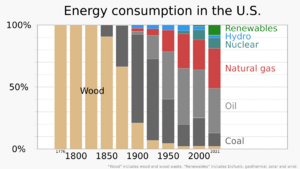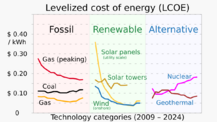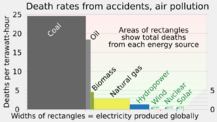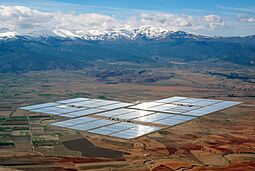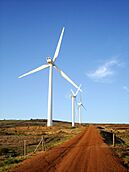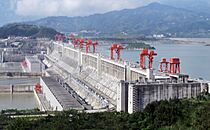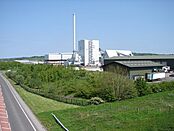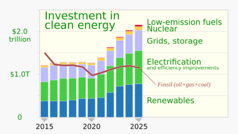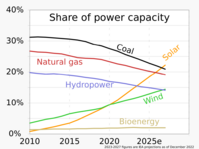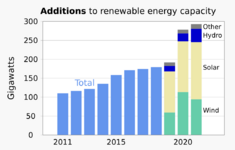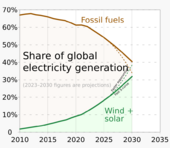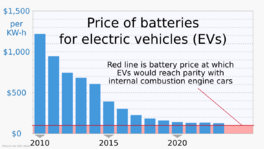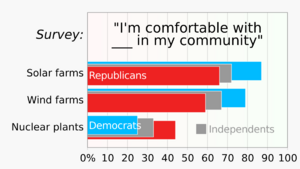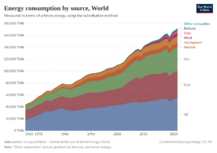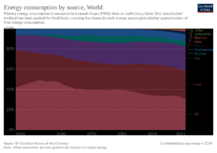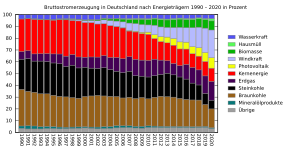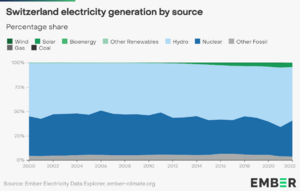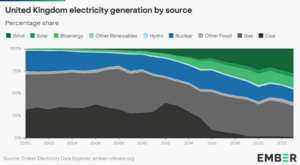Energy transition facts for kids
An energy transition is a big change in how we get and use energy. Right now, the world is moving towards sustainable energy to help stop climate change. Most sustainable energy comes from renewable energy sources like solar and wind. This change aims to quickly reduce greenhouse gas emissions by using less fossil fuels and switching to clean electricity. In the past, during the Industrial Revolution (starting around 1760), people switched from burning wood to using coal, then oil, and later natural gas.
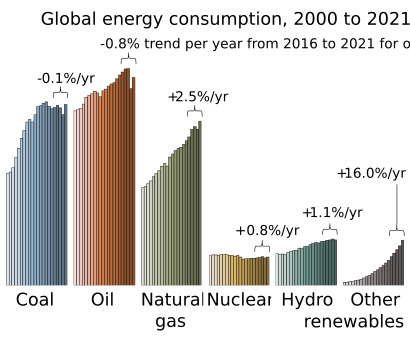
More than three-quarters of the world's energy still comes from burning fossil fuels. This creates greenhouse gases that harm our planet. Energy production and use cause most of the greenhouse gases made by humans. To meet the goals of the 2015 Paris Agreement on climate change, we need to cut emissions fast and reach net-zero by the middle of the century. Since the late 2010s, the switch to renewable energy has also sped up because solar and wind power have become much cheaper. After 2024, clean energy is more affordable than ever. For example, global solar panel prices dropped by 35 percent. Another good thing about this energy change is that it can reduce health problems and harm to the environment caused by the energy industry.
Heating buildings is changing to use electricity, with heat pumps being the most efficient way. To make electrical grids more flexible, we need more energy storage and super grids. This helps us use energy from sources like solar and wind, which depend on the weather. However, money given to fossil fuel companies is slowing down the energy transition.
Contents
What is an Energy Transition?
An energy transition is a big shift in the technologies and ways people behave to replace one energy source with another. A good example is when we moved from using wood, wind, water, and muscle power to using machines, steam power, and coal during the Industrial Revolution.
The IPCC (a group of experts on climate change) says that a "transition" is the process of changing from one state to another over time. This can happen for people, companies, cities, or even whole countries.
How the Term "Energy Transition" Developed
After the 1973 oil crisis, politicians and the media started using the term energy transition. US President Jimmy Carter made it popular in 1977. He talked about how people had changed how they used energy twice before. He said that because we were running out of gas and oil, we needed to quickly change again. This new change would focus on saving energy and using renewable energy sources like solar power. The term became known worldwide after another oil crisis in 1979.
From the 1990s, discussions about energy transition started to include climate change mitigation. Countries agreed to try and keep global warming "well below 2 °C, preferably 1.5 °C" compared to before factories became common. This means we need a fast energy transition to reduce fossil fuel use and stay within our carbon emissions limit.
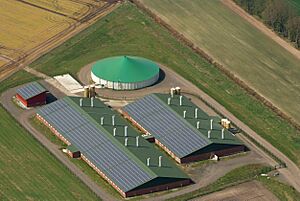
In this context, energy transition also means changing energy policy. This could mean moving from big, central power plants to smaller, local ones. It also includes trying to save energy and use it more efficiently, instead of making too much or wasting it.
Some people argue that "energy transition" is just a catchy phrase. They say that as of 2024, we are still using more of all types of energy, not just switching from one to another.
Past Energy Changes
When we look at past energy changes, there are two main ideas. One idea says that humans have gone through several energy transitions. The other idea suggests that "energy additions" is a better way to describe how global energy supply has changed.
The first idea, described by Vaclav Smil, focuses on how the main energy sources used by countries and the world economy have changed. By looking at percentages, it shows that energy systems have changed a lot over time. We went from using mostly biomass to coal, then oil, and now a mix of coal, oil, and natural gas. Before the 1950s, energy systems were mostly local, not global.
The second idea, described by Jean-Baptiste Fressoz, points out that politicians, not historians, first used the term "energy transition" to describe a future goal. When we look at the total amount of energy humans use, we see that we are always using more of all the main energy sources. For example, when coal use increased in the 19th century, people didn't stop burning wood; they actually burned more wood. Another example is cars in the 20th century. They led to more oil use (for driving) and more coal use (to make the steel for cars). So, this idea suggests that humans have never truly switched from one energy source to another, but rather kept adding new ones.
Today's energy transitions are different because of their reasons, goals, and how they are managed. As societies developed, different national energy systems became more connected, forming the large international systems we see today. Historical energy changes usually took many decades. However, the current energy transition might be faster because of new policies and technologies.
History can teach us many lessons for current energy systems. For example, in the 18th century, Britain ran out of easily accessible wood. This fuel crisis led to a chain of events that resulted in the Industrial Revolution. Similarly, more use of peat and coal helped lead to the Dutch Golden Age. Another example is 19th-century whaling: whale oil was eventually replaced by kerosene and other products from petroleum. To speed up the energy transition, governments might even buy out or help coal mining regions.
Why We Need the Current Energy Transition
(Levelized cost of energy (LCOE) is the average cost to produce electricity from a power plant over its whole life.)
Fighting Climate Change
We need a fast energy transition to very low or zero-carbon sources to reduce the effects of climate change. Burning coal, oil, and gas causes 89% of carbon dioxide (CO2) emissions and still provides 78% of the world's energy.
Even though we know about the risks of climate change and have more climate policies since the 1980s, energy transitions haven't sped up enough to reach climate goals.
Using renewable energy can also bring other good things, like creating jobs, helping industries grow, improving health, and giving more people access to energy. Replacing coal power plants can more than double the number of jobs for the same amount of power. The energy transition could create many green jobs, for example, in Africa. Training workers for the renewable energy industry is not very expensive. In rural areas without electricity, solar mini-grids can greatly improve access to power.
Green jobs are linked to using renewable energy or building new infrastructure and making improvements.
Energy Security
Another important reason for the transition is energy security and independence. This has become more important in Europe and Taiwan because of the 2022 Russian invasion of Ukraine. Unlike Europe's dependence on Russian gas in the 2010s, even if China stops supplying solar panels, the ones already installed keep making electricity. Militaries are using and developing electric vehicles, especially because they are quiet.
Big central facilities like oil refineries and thermal power plants can be damaged by air attacks. However, decentralized power sources like solar and wind might be less vulnerable. Solar and batteries reduce the need for risky fuel convoys. But large hydropower plants can be vulnerable. Some people say nuclear power plants are unlikely military targets, but others believe that civilian nuclear plants in war zones could be used by hostile forces to stop energy supplies or to threaten a nuclear disaster.
Economic Growth
For many developing countries, like those in mineral-rich Sub-Saharan Africa, the switch to renewable energies is expected to help their economies grow in a sustainable way. The International Energy Agency (IEA) has identified 37 minerals that are very important for clean energy technologies. They estimate that by 2050, the global demand for these minerals will increase by more than triple. Africa has large amounts of many of these "green minerals," such as bauxite, cobalt, copper, chromium, manganese, and graphite. The African Union has a plan, the Africa Mining Vision, to use the continent's minerals to achieve sustainable development and economic change. To reach these goals, African countries with minerals need to move from just exporting raw materials to making more valuable products.
Renewable Energy Costs Less
From 2010 to 2019, wind and solar power became much more competitive. The cost of solar energy dropped sharply by 85%, wind energy by 55%, and lithium-ion batteries by 85%. This has made wind and solar power the cheapest option for new power plants in many places. The costs for combining onshore wind or solar with a few hours of storage are already lower than for gas power plants that only run during peak demand. In 2021, new renewable electricity capacity made up over 80% of all new power installed.
Key Technologies and Approaches
To keep global warming below 2 °C, we need to completely change how energy is made, moved, stored, and used. For a society to switch from one energy type to another, many technologies and behaviors in the energy system must change.
Many plans to fight climate change focus on three main things for a low-carbon energy system:
- Using energy sources that produce low emissions to make electricity.
- Electrification – using more electricity instead of directly burning fossil fuels.
- Using energy more efficiently.
Renewable Energy Sources
The most important energy sources in the low-carbon energy transition are wind power and solar power. They could reduce carbon emissions by billions of tons each year. Other renewable energy sources include bioenergy, geothermal energy, and tidal energy.
By 2022, hydroelectricity was the largest source of renewable electricity, providing 16% of the world's total electricity in 2019. However, its growth is limited because it depends a lot on geography and can have big environmental and social impacts. Wind and solar power are considered easier to expand and have grown very fast recently because their costs have dropped quickly. In 2019, wind power supplied 5.3% of worldwide electricity, and solar power supplied 2.6%.
While hydropower can be controlled, wind and solar power depend on the weather. Electrical grids need to be expanded and adjusted to avoid wasting energy. Hydropower from dams can be turned on and off as needed, but solar and wind are variable renewable energy sources. These sources need backup power or energy storage to provide continuous and reliable electricity. For this reason, storage technologies are also very important in the renewable energy transition. As of 2020, the largest storage technology is pumped storage hydroelectricity. Other important forms of energy storage are electric batteries and power to gas.
The "Electricity Grids and Secure Energy Transitions" report by the IEA says that we need to increase grid investments to over $600 billion each year by 2030. This is up from $300 billion. This is needed to connect more renewable energy. By 2040, the grid must grow by more than 80 million kilometers to handle renewable sources. These sources are expected to make up over 80% of the global power increase in the next two decades. If we don't improve grid infrastructure in time, it could lead to an extra 58 gigatonnes of CO2 emissions by 2050, making it harder to limit global temperature rise to 2°C.
Connecting Variable Renewable Energy
With more renewable energy, local electricity production becomes more variable. Experts suggest that connecting different energy sectors, using energy storage, smart grids, and managing demand will be needed to use a lot of renewables. Fluctuations can be smoothed out by combining wind and solar power and by extending electricity grids over large areas. This makes us less dependent on local weather.
With prices changing a lot, electricity storage and grid expansion become more useful. Researchers have found that the costs for connecting variable renewable energy sources to electricity systems are expected to be small until 2030. Also, it will be more challenging to power the entire energy system with only renewable energy.
Fast changes in power increase with a lot of wind and solar energy. These can be handled by backup power. Large batteries can react in seconds and are increasingly used to keep the electricity grid stable.
100% Renewable Energy
Some plans aim for 100% renewable energy.
Nuclear Power
In the 1970s and 1980s, nuclear power became a big part of the energy mix in some countries. In France and Slovakia, more than half of the electricity still comes from nuclear power. It is a low-carbon energy source, but it has risks and increasing costs. Since the late 1990s, fewer new nuclear plants have been built. Old reactors are being shut down, sometimes because they are at the end of their life, or sometimes because people are against nuclear power. Germany closed its last three nuclear power plants by mid-April 2023. On the other hand, the China General Nuclear Power Group plans to have 200 GW of nuclear power by 2035, built by 150 more reactors.
Electrification
As we switch to clean energy sources that make electricity, things that use energy, like transportation and heating, need to be electrified. This means they will run on clean electricity. At the same time, the electricity grid needs to expand to handle more electricity. Two key areas of electrification are electric vehicles and heat pumps.
It is easier to make electricity in a sustainable way than it is to make liquid fuels sustainably. So, using electric vehicles helps make transport more sustainable. While electric vehicle technology is quite developed for road transport, electric shipping and aviation are still new. This means sustainable liquid fuels might still be important for these sectors.
A key sustainable solution for heating is electrification, using heat pumps or less efficient electric heaters. The IEA estimates that heat pumps currently provide only 5% of global space and water heating, but they could provide over 90%. Using ground source heat pumps not only reduces the total energy needed for heating and cooling, but it also makes electricity demand more even. However, heat pumps and electric heating alone won't be enough for industrial heat, because some processes need much higher temperatures. For example, making ethylene needs temperatures as high as 900 °C. So, completely new processes are needed. Still, using electricity for heat is expected to be the first step in electrifying the chemical industry, with large-scale use expected by 2025.
Money and Global Power in Energy Transition
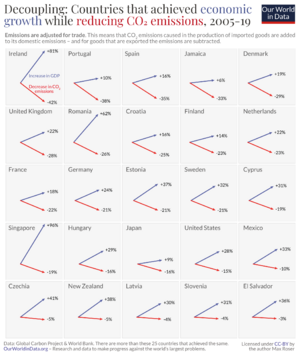
Changing energy sources can change relationships and dependencies between countries, groups, and companies. Countries or landowners with fossil or renewable resources could gain or lose a lot depending on how the energy transition develops. In 2021, energy costs were 13% of the world's total economic output. Global competition has also driven the economics behind the low-carbon energy transition. New technologies developed in one country can become a strong economic force.
Influences on the Transition
Discussions about the energy transition are greatly influenced by fossil fuel industries. One way oil companies continue their work, despite growing environmental and social concerns, is by lobbying local and national governments.
Historically, the fossil fuel lobby has been very good at limiting rules. From 1988 to 2005, Exxon Mobil, a very large oil company, spent almost $16 million on lobbying against climate change and giving misleading information to the public. The fossil fuel industry gets a lot of support from existing banks and investment firms. The idea that this industry should no longer be financially supported has led to a social movement called divestment. Divestment means taking investment money out of stocks, bonds, or funds in oil, coal, and gas companies for both moral and financial reasons.
Banks, investment firms, governments, universities, and businesses are all being challenged with this new moral argument against their investments in the fossil fuel industry. Many, like Rockefeller Brothers Fund, the University of California, and New York City, have started to shift to more sustainable, eco-friendly investments.
In 2024, the International Renewable Energy Agency (IRENA) predicted that by 2050, over half of the world's energy will be electricity, and over three-quarters of the global energy mix will come from renewables. Although biomass and clean hydrogen will be more common, fossil fuels were still expected to supply 12% of energy. The transition is expected to change global power by reducing reliance on long-distance fossil fuel trade and making regional energy markets more important.
Social and Environmental Aspects
Impacts of the Transition
A renewable energy transition can have negative social impacts for some people. This includes those who depend on the current energy economy or who are affected by mining for minerals needed for the transition. This has led to calls for a just transition. The IPCC defines this as "principles, processes, and practices that aim to ensure no people, workers, places, sectors, countries, or regions are left behind when moving from a high-carbon to a low-carbon economy."
Using local energy sources can help local economies, create opportunities for energy trade between communities, and increase energy security.
Coal mining is very important for the economy in some regions. A switch to renewables would make coal mining less viable and could severely impact communities that rely on it. These communities might already face energy poverty. They also face economic collapse when coal mining businesses leave or disappear. This situation makes poverty worse and makes these communities less able to adapt. One possible solution could be to expand programs that help vulnerable communities with new training, economic development, and support during the transition.
Higher energy prices from an energy transition might negatively affect developing countries like Vietnam and Indonesia.
More mining for lithium, cobalt, nickel, copper, and other important minerals needed for renewable energy infrastructure has led to more environmental conflict and environmental justice issues for some communities.
Workers and Jobs
Many people around the world work directly or indirectly for the fossil fuel economy. Also, many other industries currently depend on energy sources that are not sustainable, like the steel industry or cement and concrete industry. Helping these workers during a fast economic change needs careful thought and planning. The international labor movement has asked for a just transition that addresses these concerns.
Recently, Europe faced an energy crisis because it depended on Russia's natural gas, which was cut off during the Russia-Ukraine war. This shows that humanity still relies heavily on fossil fuel energy sources. We need to be careful to have a smooth transition so that energy shortages don't stop the efforts to power the transition effectively.
Challenges and Barriers
One key challenge for the global switch to renewables is how well individual electric companies can adapt. For example, electric utilities have been slow to adopt renewables because they keep investing in fossil fuel power plants.
Incomplete rules about clean energy and worries about electricity shortages have been identified as major barriers to the energy transition in countries like Vietnam, which depend on coal and are developing fast.
Researchers found that what U.S. residents think and feel can be barriers to energy transitions. The U.S. Department of Energy plans for wind energy to provide 35% of the electrical grid by 2050. This means wind energy projects are being built closer to communities. People in local communities might oppose wind energy because of noise, worries about health effects, and changes to scenic landscapes.
Expected economic impacts are believed to be the most important factor in how people view proposed wind energy projects. Economic barriers to accepting renewable energy include local tax increases, higher electricity rates, less tourism, impacts on property values, and unfair distribution of benefits. However, possible benefits include rural economic development, job creation, investment opportunities, and lower electricity costs.
Examples by Country
From 2000 to 2012, coal was the energy source that grew the most. The use of oil and natural gas also grew a lot, followed by hydropower and renewable energy. Renewable energy grew faster than ever before during this time. The demand for nuclear energy decreased, partly because of well-known accidents (Three Mile Island in 1979, Chernobyl in 1986, and Fukushima in 2011). It also decreased because nuclear energy became more expensive than other large-scale alternatives.
More recently, coal use has declined compared to low-carbon energy. Coal dropped from about 29% of the global total primary energy use in 2015 to 27% in 2017. Non-hydro renewables increased to about 4% from 2%.
Asia
China's Energy Policy
China's Fourteenth Five-Year Plan put more focus on the green transition. This is seen as essential for China to achieve high-quality and sustainable growth.
India's Energy Goals
India has set renewable energy goals to get 50% of its total energy from renewable sources, as part of the Paris climate accords. As of 2022, the Central Electricity Authority is on track to meet its goals. It produces 160 GW of electricity from clean sources like solar, wind, hydro power, and nuclear power plants. This is 40% of its total capacity. India is ranked third on Ernst and Young's renewable energy country attractiveness index, behind the US and China.
Hydroelectric power plants have been a major part of India's energy system since its independence in 1947. Former Prime Minister Jawahar Lal Nehru called them the "temples of modern India." He believed they were key to making the new country modern and industrial. Important hydropower stations include the 2400 MW Tehri hydropower complex and the 1960 MW Koyna hydroelectric project. Recently, India has focused on new renewable technologies like solar power plants and wind farms. It has 3 of the world's top 5 solar farms, including the world's largest, the 2255 MW Bhadla Solar Park.
While there has been positive change, air pollution from coal still causes many deaths. India needs to reduce its reliance on traditional coal-based power production, which still accounts for around 50% of its energy production. India is also working towards its goal of electrifying the automotive industry, aiming for at least 30% EV ownership among private vehicles by 2030.
Vietnam's Energy Transition
Vietnam has led Southeast Asia in using solar and wind power, reaching about 20 GW in 2022 from almost zero in 2017. Thailand has the most EV registrations, with 218,000 in 2022. The energy transition in Southeast Asia is challenging but achievable, and it depends a lot on international support.
Public demand for better local environmental quality and the government's goals to promote a green economy are key reasons for the transition in Vietnam. The government's desire to attract international support for green growth and public demand for a clean environment have driven the energy transition in developing countries like Vietnam. Thanks to a more favorable investment environment, Vietnam is set for a faster energy transition than some other ASEAN countries.
Europe
European Union's Green Deal
The European Green Deal is a set of plans by the European Commission to make Europe climate neutral by 2050. A plan will also be presented to increase the EU's greenhouse gas emission reductions target for 2030 to at least 50% and towards 55% compared with 1990 levels. The plan is to review every existing law to see how it affects climate, and also introduce new laws on the circular economy, building renovation, biodiversity, farming, and innovation. The president of the European Commission, Ursula von der Leyen, said the European Green Deal would be Europe's "man on the Moon moment." This plan would make Europe the first climate-neutral continent.
A survey found that companies using advanced digital technologies invested more in energy-saving strategies. In the European Union, 59% of companies that invested in both basic and advanced technologies also invested in energy efficiency. This is compared to only 50% of US firms in the same category. Overall, there is a big difference between how digitally advanced businesses are and how much they invest in energy efficiency.
Germany's Energy Shift
Germany has played a very big role in moving away from fossil fuels and nuclear power to renewables. The energy transition in Germany is called die Energiewende (meaning "the energy turn"). This shows a shift from old fuels and technologies to new ones. The main plan for the Energiewende was published by the German government in September 2010, about six months before the Fukushima nuclear accident. Laws to support it were passed in September 2010.
The German federal government has supported this policy, leading to a huge increase in renewables, especially wind power. Germany's share of renewables grew from about 5% in 1999 to 17% in 2010, reaching close to the average for developed countries (OECD) of 18%. In 2022, Germany's share was 46.2%, surpassing the OECD average. A big reason for this increase in renewables is the lower cost of capital. Germany has some of the lowest capital costs for solar and onshore wind energy worldwide. In 2021, the International Renewable Energy Agency reported capital costs of around 1.1% for solar and 2.4% for onshore wind. This is a big drop from numbers in the early 2000s, where capital costs were around 5.1% and 4.5% respectively. This decrease was influenced by various economic and political factors. After the 2008 financial crisis, Germany made it easier for banks to lend money cheaply with low interest rates to boost the economy.
During this time, the renewable energy industry also started to learn and improve in manufacturing, project organization, and financing. This happened because of more investment and orders. This, along with different types of subsidies, greatly reduced the capital cost and the levelized cost of electricity (LCOE) for solar and onshore wind power. As these technologies have become more mature and a key part of the energy system, it is expected that in the future, experience and general interest rates will be the main factors for how competitive these technologies are.
Producers have been guaranteed a fixed payment for 20 years, ensuring a steady income. Energy co-operatives have been created, and efforts were made to spread control and profits more widely. The large energy companies have a very small share of the renewables market. Nuclear power stations were closed, and the remaining nine stations closed earlier than planned, in 2022.
Reducing reliance on nuclear stations has led to more reliance on fossil fuels. One factor that has slowed down the efficient use of new renewable energy is the lack of investment in power infrastructure to bring the power to market. It is believed that 8300 km of power lines need to be built or upgraded.
Different German states have different opinions on building new power lines. Industry rates have been frozen, so the increased costs of the Energiewende have been passed on to consumers, who have seen rising electricity bills. In 2013, Germans had some of the highest electricity costs in Europe. However, for the first time in over ten years, electricity prices for household customers fell at the beginning of 2015.
Switzerland's Energy Strategy
Because of the high amount of hydroelectricity (59.6%) and nuclear power (31.7%) in its electricity production, Switzerland's carbon dioxide (CO2) emissions per person related to energy are 28% lower than the European Union average. They are about the same as France's. On May 21, 2017, Swiss voters approved a new Energy Act that set up the 'energy strategy 2050'. The goals of this strategy are: to reduce energy consumption; to increase energy efficiency; and to promote renewable energies (like water, solar, wind, and geothermal power, as well as biomass fuels). The Energy Act of 2006 forbids building new nuclear power plants in Switzerland.
United Kingdom's Energy Goals
By law, greenhouse gas emissions by the United Kingdom must be reduced to net zero by 2050. To help reach this goal, national energy policy mainly focuses on off-shore wind power and building new, advanced nuclear power plants. The increase in national renewable power (especially from biomass) and the 20% of electricity from nuclear power in the United Kingdom meant that by 2019, low-carbon British electricity had overtaken that generated by fossil fuels.
To meet the net zero target, energy networks must be made stronger. Electricity is only one part of energy in the United Kingdom. Natural gas used for industrial and home heating, and petroleum used for transport in the United Kingdom, must also be replaced by electricity or another low-carbon energy form, such as sustainable bioenergy crops or green hydrogen.
Although no major political party disagrees with the need for the energy transition, in 2020 there was debate about how much money to spend on the transition to recover from the COVID-19 recession. There was also discussion about how many jobs could be created, for example, by improving energy efficiency in British housing. Some believed that due to government debt after COVID, funding for the transition would not be enough. Brexit might significantly affect the energy transition, but this was unclear as of 2020. The government urged UK businesses to sponsor the climate change conference in 2021, possibly including energy companies, but only if they had a clear short-term plan for the energy transition.
|
See also
 In Spanish: Transición energética para niños
In Spanish: Transición energética para niños
- Mobility transition
- Hydrogen economy
- List of countries by renewable electricity production
- List of energy storage power plants
- List of renewable energy topics by country and territory
- Low-carbon economy


